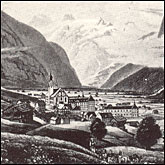The Musical Past of Switzerland

The development of serious music in Switzerland from earliest liturgic songs to the classical sounds of an 18th century opera buffa on a rustic Swiss theme.
The monks
In 720, on the site where the monk Gallus had built his hermitage, the monastery of St.Gall was founded which soon became one of Europe’s most important centers of culture.
At that time a strong bond was being forged by the Emperor Charlemagne between the secular power and the Church. A new wind of unity and progress began to blow through many parts of Western Europe.
Its inspiration an ideas sprang largely from the great monastic schools, medieval ‘campuses’ like St. Gall, where youthfull ‘studiosi’ gathered to dedicate their lives to religion and learning. A new kind of religious music was also beginning to grow.
Notker Balbulus (Stammerer)
Notker, a monk from St.Gall, was one of the greatest musical innovators of his time (second part of the 9th century). Poets and musicians north of the Alps, inspired by their Keltic-Germanic heritage, were stirring to create new songs to be added to the Roman liturgy.
Those songs, known as ‘Sequences’, became the most popular form of singing in the Middle Ages and remain inseparably linked with the name of Notker Balbulus.
Another very similar innovation were the ‘Tropes’ created in St. Gall.
Tuotilo
Tuotilo provided his own texts to melodies which he adapted from traditional Gregorian chants, sung during a Mass.(Listen to audio 1 and 2, below.)
The Troubadours, Trouvères and Minnesingers
From Carolingian times onward, more and more elements of folklore were used in art music. Church and State were soon to go their own ways, due to growing political ambitions of the Church and increasing independence of the courts. Consequently, this period witnessed the emergence of a courtly secular music. This trend culminated in the songs of the Troubdours, Trouvères and Minnesingers.
In the second half of the twelfth century, somewhere on the shore of Lake Neuchâtel, at the foot of the Jura Mountains, one of he earliest Minnesingers,
Rudolf von Fenis
composed verses and melodies. (Listen to audio 3, below.)
Ludwig Senfl – one of the moust outstanding and influential composers of the Renaissance
In his music, Senfl speaks the language of a period in which the importance of the individual is being stressed more then ever before.
Europe north of the alps fell into two camps – Catholic and Protestant. Ludwig Senfl never seems to have made a clear choice. In the years following the Reformation, we find him at the Court of Bavaria in the service of a Catholic prince. At the same time, he is in clandestine contact with members of the Protestant faction in Germany; he even corresponds directly with Martin Luther.
Senfl’s ambiguity is also reflected in his work. Drawing inspiration from the very essence of folk music, he is also a skilled practitioner of the fine arts, equaly at ease in the grand splendor of the imperial court and of the Catholic Church. (Listen to audio 4, below.)
Calvin and Loys Bourgeois
In Protestant Geneva, the opulance of the Renaissance was banished by the austere reformer Calvin who was also strongly opposed to all music “composed solely for the pleasure of the ear”. If music were to be retained in any form in the church service, an entirely different repertoire of religious songs had to be created.
In Loys Bourgeois, Calvin found a musician who was willing to help him in this undertaking. In 1547, Bourgeois published his ‘Psalms of David’, compositions in a simple four-part setting, to be sung by the congregation during the services.(Listen to audio 5, below.)
Jean-Jacques Rousseau, the great social philosopher from Geneva
A man of many talents, Rousseau was also keenly interested in music, wrote a great deal about music, composed all kinds of works, and even compiled a highly interesting ‘Dictionary of Music’. Practically, all his compositions reflect his political and philosophical ideals, summed up in the expression ‘Back to Nature’.
Instead of writing an opera with divinities, heroes and stilted grandees – stock figures of any opera of the time – he presented the court with his musical comedy ‘Le Devin du Village’ (The Village Soothsayer) wich tells of the love entanglements of simple rural folk. (Listen to audio 6, below.)
Franz Joseph Leonti Meyer von Schauensee
The last representative Swiss composer of the period preceding the French revolution.
Born in central Switzerland of an aristocratic family, he was sensitive enough to his environment to relate his work to the needs of the common people. This is the best shown in the ‘Engelberger Talhochzeit’, an opera buffa which reveals Rousseau’s influence on Meyer von Schauensee.
The ‘Aria of Baschi’ from ‘A Wedding in the Valley of Engelberg’ is sung in the rustic dialect of the central Swiss canton of Unterwalden, a striking contrast to Meyer von Schauensee’s elegant musical language. (Listen to audio 7, below.)
Carillon of Conthey
Divergent in character, the early Swiss composers all had one thing in common: an attunement to the musical idiom of the people. Instinctively aware of their democratic background, they were involved in the natural joy which people find in making music.
The simple melody of a carillon in the Rhone Valley – token of the musical pleasures of a people, symbol of a cultural heritage in Switzerland reaching back over more than 1000 years. (Listen to audio 8, below.)

In compliance with the JTI standards
More: SWI swissinfo.ch certified by the Journalism Trust Initiative
You can find an overview of ongoing debates with our journalists here . Please join us!
If you want to start a conversation about a topic raised in this article or want to report factual errors, email us at english@swissinfo.ch.